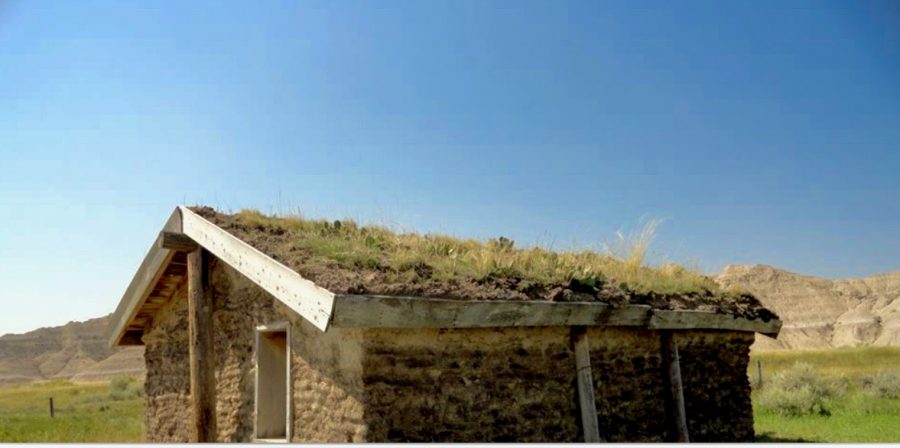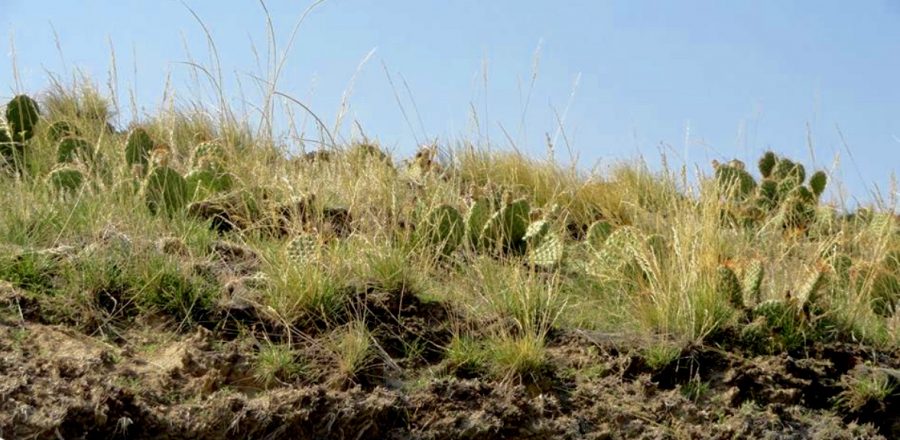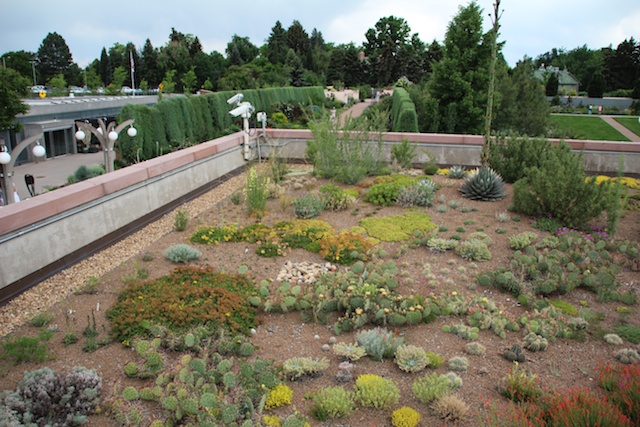A sod roof in Nebraska appeared in our facebook feed the other day. And what a good looking green roof it is. Yet there is more to this than looking good. Firstly sod houses in the mid-west of North America are historically important. And secondly in the soil and plants, there may be secrets that can inform the future of modern green roofs.
Sod roofs were a practical solution to a real challenge for those who built them. Staying alive in the severe continental winters of the prairies was one thing. Then there was the extreme heat of the prairie summer. A sod roof was all about succeeding in the prairie.The roofs were built to last. They were an immediate response to a lack of timber on the treeless plains.

View of a sod roof in Nebraska. Photo credit: Pam Malmgren-Wanek
A brief history of sod roofs in the prairie
Of course it is the green roof that interests us here. Yet the history of sod roofs is informative if one is considering building a green roof in the prairies. And we suspect there has been little research on what vegetation is flourishing on these roofs. But I will come to that.
Apparently, the first building made out of sod in Nebraska was at Fort Kearny in the late 1840s. Settlers across the prairies made use of sods for roofs (and walls) not just in Nebraska, but also in other states and prairie provinces in Canada. A brief search online highlights an important consideration when selecting the ‘sod’. To build a sod house, you needed the right kind of grass — grass with densely packed roots to will hold the soil together.The settlers knew or learnt how to search for these types of sods. So Nebraska settlers would search the prairie for buffalo grass, little blue stem grass, wire grass, prairie cord grass, Indian grass and wheat grass. And presumably growing amongst these grasses were the wildflowers of the prairie too.
We have seen sod roofs on programmes about the prairies. Even Kevin Costner sought shelter in a grass roof in Dances With Wolves. There are videos of sod houses but these tend to be of Norwegian style ‘turf’ roofs. However, this one in Eutis Nebraska gives a feel of what they look like. Sadly we suspect there are few examples of these buildings remaining. Many were, in fact, temporary until better materials could be located.

Cacti growing on a sod roof in Nebraska. Photo credit: Pam Malmgren-Wanek
What plants grow on a sod roof?
Now looking at the roof, the depth of the soil doesn’t look to be more than 20cm (8 inches). So though the grasses may have been deep rooted to reduce erosion, surely these grasses died out? Presumably only the toughest short rooted grasses lasted over time?
We suspect there has been little research on what vegetation is flourishing on the sod roofs that remain. Yet we are sure it would be informative. As can be seen above, prickly pear cactus is thriving. There is probably little blue stem on the roof, as this is a known green roof grass in North America. But are there wildflowers growing up there too? Are there penstemons and geums? And perhaps the wildflowers on the last remaining sod houses would give a perspective on grasslands communities of 150 years ago before industrial agriculture hit the plains.
Though sod and turf houses are celebrated from a cultural and historical perspective, both in the green roof and wider community, there are potentially lessons to be learned. Such lessons could inform how green roofs in the prairie states could be built. Rather than using industrial systems a native approach could be more resilient.
The Colorado Native Plant Society and the Denver Botanical Garden
The images above appeared on the Colorado Native Plant Society Facebook page. We are grateful to Pam Malmgren-Wanek for allowing me to use the pictures. Though not in Colorado, Pam thought the roofs would be of interest to the society.
Denver now has a mandatory green roof policy. There have been questions raised about how green roofs will look throughout the year in the Colorado climate. Yet prior to the adoption of the mandatory requirement the Denver Botanical Garden explored the possibility of using native mid-west plants on green roofs. It is a very interesting roof. Yet it doesn’t fit the industrial scale character of how the construction industry perceives green roofs.

Green roof – Denver Botanical Gardens
As this excellent article in the Denverite notes: “If you want a lawn, that’s crap. There are no lawns in Colorado. There shouldn’t be. Our grass should be yellow most parts of the year, that’s how it is.’ Like a prairie. Like a prairie on a sod roof in Nebraska perhaps.
Green colour or green performance – local plants are part of the story
Is a green roof about performance or is it about colour? This is an important question, not only in regions that have severe summers but everywhere. The rise of industrial green roofing systems aims to ensure a green colour all year round. Yet this require water and fertiliser. The yearning for green all year round is not necessarily sustainable in the long term. Plants not associated with the locale are generally planted on mass. We believe resilient cities will rely on resilient vegetation. Where better to look for such vegetation than in the region itself.
So perhaps researchers should visit a sod roof in Nebraska and let it tell a story. A story from the recent past that could tell a story for the future.
The nature of our guide is to encourage the use of local plants whether in Cornwall, Washington State or Switzerland. And in terms of its techniques, it does reflect the ingenuity and graft of the early settlers.